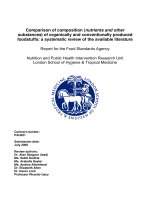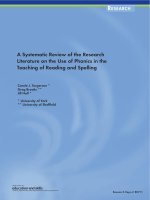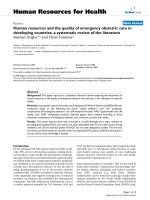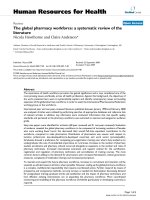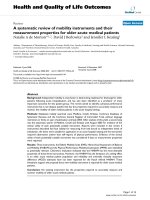a systematic review of the research literature on the use of phonics in the teaching of reading and spelling
Bạn đang xem bản rút gọn của tài liệu. Xem và tải ngay bản đầy đủ của tài liệu tại đây (664.67 KB, 85 trang )
A Systematic Review of the Research
Literature on the Use of Phonics in the
Teaching of Reading and Spelling
Carole J. Torgerson *
Greg Brooks **
Jill Hall *
* University of York
** University of Sheffield
Research Report RR711
RESEARCH
Research Report
No 711
A Systematic Review of the Research
Literature on the Use of Phonics in the
Teaching of Reading and Spelling
Carole J. Torgerson *
Greg Brooks **
Jill Hall *
* University of York
** University of Sheffield
The views expressed in this report are the authors’ and do not necessarily reflect those of the Department for
Education and Skills.
© The University of Sheffield 2006
ISBN 1 84478 659 5
Contents
Page
et al
et al
List of Tables
Page
List of Figures
Page
The review team
Steering Group
f
f
f
f
f
f
Acknowledgements
Glossary
Analytic phonics:
pet, park, push, pen
*Attrition:
*Bias:
Cluster randomized trial:
*Concealed allocation:
*Confidence intervals:
*CONSORT:
*Controlled trial (CT):
*Co-variates or confounders:
*Effect size:
*Funnel plot:
Heterogeneity:
*ITT analysis: Intention to teach analysis:
Intra-cluster correlation (ICC):
Meta-analysis
Meta-analysis: fixed effects model:
Meta-analysis: random effects model:
Normal quantile plot:
Onset-rime:
Phonics instruction:
*Publication bias:
*Randomized Controlled Trial (RCT):
*Regression to the mean:
*Sample size calculations:
*Standard deviation:
Synthetic phonics:
Systematic review:
EXECUTIVE SUMMARY
Introduction
f
Key findings
The effect of phonics on reading:
accuracy
accuracy
et al
comprehension
The effect of synthetic and analytic phonics
The effect of phonics on spelling:
Definitions
Phonics instruction
Synthetic phonics
Analytic phonics
pet, park, push, pen.
Systematic phonics
Aims of the review
Background
f
Methods
et al et al
Findings
accuracy
comprehension
Conclusions
Recommendations
For teaching
However,
For teacher training
For research
1. Introduction
f
et al
2. Objectives: The review questions
How effective are different approaches to phonics teaching in comparison to each
other (including the specific area of analytic versus synthetic phonics)?
How do different approaches impact on the application of phonics in reading and
writing, including beyond the early years?
What proportion of literacy teaching should be based on the use of phonics?
Is there a need to differentiate by phonics for reading and phonics for spelling?
3. Definitions
Phoneme
bat, pat
Grapheme
push
Synthetic phonics
cat
dog
Analytic phonics
pat, park, push pen
reading
et al.
stop
put, pig, play, pet
4. Previous research (1): Narrative reviews
Learning to Read: The Great Debate
5. Previous research (2): The Ehri et al. (2001) systematic review and
the Camilli et al. (2003) replication
et al.
et al
et al
et al.
et al.
et al.
et al.
et al.
et al.
et al
Methodological limitations of the Ehri et al. (2001) review
et al.
et al.
et al.
et al.
et al.
et al.
et al.
6. The British context
Attention to phonics
Framework for Teaching f
f
To what extent, and in what ways, does the phonics element of
the National Literacy Strategy need modifying?
Trends in attainment, and doubts about them
passim
Recent British research
et al.
et al.
et al.
et al
Political attention
7. The use of randomized controlled trials in effectiveness research
et al.


